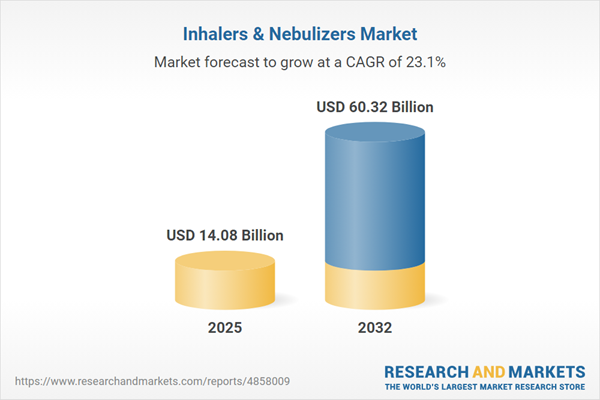Speak directly to the analyst to clarify any post sales queries you may have.
Senior leaders in the inhalers & nebulizers market contend with rapid digital advances, changing regulations, and growing expectations for patient-centered care. In this dynamic setting, strategic innovation and operational flexibility are crucial for sustaining competitive advantage and fulfilling evolving healthcare demands.
Market Snapshot: Inhalers & Nebulizers Market Growth Trajectory
The inhalers & nebulizers market maintains a robust growth trajectory, reporting a strong compound annual growth rate paired with steady year-over-year gains. This expansion is propelled by climbing numbers of respiratory health cases and the widespread adoption of advanced devices integrated into digital health solutions. Technology investments focus on optimizing medication delivery and supporting efficient clinical workflows, while partnerships and collaborations enable industry players to respond to regulatory changes and emerging patient needs in diverse global markets.
Scope & Segmentation of the Inhalers & Nebulizers Market
- Product Types: Dry powder inhalers, metered dose inhalers, soft mist inhalers, jet nebulizers, mesh nebulizers, and ultrasonic nebulizers, each address acute and chronic respiratory treatment needs, offering different delivery methods aligned to varied clinical preferences and patient situations.
- Therapeutic Classes: Anticholinergics, bronchodilators, corticosteroids, and mucolytics cover both short-term symptom management and long-term respiratory care, enabling tailored therapy for improved patient outcomes.
- Indications: Asthma, chronic obstructive pulmonary disease, and cystic fibrosis remain at the forefront, reflecting the primary areas of concern in respiratory health and the ongoing need for patient-centric approaches.
- Distribution Channels: Hospital pharmacies, retail outlets, and online platforms increase reach, simplifying acquisition and extending product access to varied care environments and patient groups.
- End Users: Hospitals, ambulatory care centers, clinics, and homecare providers require dependable and timely device supply to ensure seamless care delivery and ongoing treatment support.
- Regions: Americas, Europe, Middle East & Africa, and Asia-Pacific present different regulatory demands and technology adoption rates, calling for region-specific approaches in market positioning and compliance efforts.
- Major Companies: GlaxoSmithKline plc, Boehringer Ingelheim International GmbH, AstraZeneca plc, Teva Pharmaceutical Industries Ltd., Novartis AG, Cipla Limited, Viatris Inc., Koninklijke Philips N.V., Omron Corporation, and PARI GmbH consistently advance sector development through innovation, collaboration, and research partnerships.
Key Takeaways for Senior Decision-Makers
- Accelerated digital integration in inhalers and nebulizers enhances medication adherence, enables remote monitoring, and aligns with telehealth expansion in clinical practice.
- Prioritizing user-friendly device design and recyclable materials supports both patient needs and compliance with evolving environmental regulations.
- Deploying resilient supply chain models, such as modular production and adaptable sourcing, mitigates supply disruptions and maintains reliable device availability.
- Integration of respiratory devices into healthcare IT systems fosters workflow automation, improving coordination across hospital and homecare transitions.
- Scaling domestic production capabilities strengthens responsiveness and readiness for emerging regulatory requirements in fluctuating market conditions.
Tariff Impact on Global Supply Chains
Adjusting to anticipated US tariff updates, respiratory device manufacturers are increasing their focus on domestic sourcing and improving logistics frameworks. These moves enhance risk management and ensure consistent product delivery as new regulatory expectations redefine inhaler and nebulizer market standards.
Methodology & Data Sources
This report synthesizes extensive secondary research, targeted interviews with industry experts, analysis of recent clinical trials, regulatory assessments, and latest procurement trends. The insights reflect senior leadership perspectives and inform benchmarking and planning strategies.
Why This Report Matters
- Enables executive teams to refine strategic models, implement device innovations, and streamline respiratory care operations across organizational levels.
- Offers actionable guidance for successfully responding to regulatory adjustments and advancing digital transformation within clinical and administrative workflows.
- Supports decisive supply chain management, ensuring organizations maintain stability and adaptability as market expectations and standards continue to evolve.
Conclusion
This report equips senior leaders to drive forward progress, leverage integrated respiratory technology, and achieve organizational objectives in an intricate, evolving regulatory and clinical arena.
Additional Product Information:
- Purchase of this report includes 1 year online access with quarterly updates.
- This report can be updated on request. Please contact our Customer Experience team using the Ask a Question widget on our website.
Table of Contents
3. Executive Summary
4. Market Overview
7. Cumulative Impact of Artificial Intelligence 2025
Companies Mentioned
The companies profiled in this Inhalers & Nebulizers market report include:- GlaxoSmithKline plc
- Boehringer Ingelheim International GmbH
- AstraZeneca plc
- Teva Pharmaceutical Industries Ltd.
- Novartis AG
- Cipla Limited
- Viatris Inc.
- Koninklijke Philips N.V.
- Omron Corporation
- PARI GmbH
Table Information
| Report Attribute | Details |
|---|---|
| No. of Pages | 187 |
| Published | October 2025 |
| Forecast Period | 2025 - 2032 |
| Estimated Market Value ( USD | $ 14.08 Billion |
| Forecasted Market Value ( USD | $ 60.32 Billion |
| Compound Annual Growth Rate | 23.0% |
| Regions Covered | Global |
| No. of Companies Mentioned | 11 |









